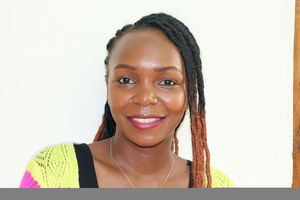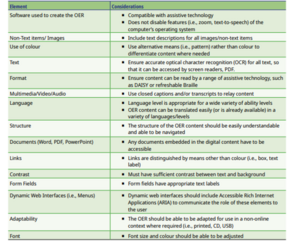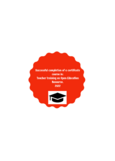User:Veronicah
[[User:Veronicah | Veronicah Wangui]]
I have been working on Digital learning in emergencies and I have added an article on Digital learning in emergencies#Accessible Digital Learning in Emergencies. This article describes the guidelines required when creating digital learning resources in emergencies so as to ensure they are accessible for all children with and without disabilities without causing the digital divide due to the disabilities. The article offers guidance on how to create content for people with different types of impairments including visual, hearing, physical, language, and cognitive impairments.
Biography
I am Veronicah Wambui Wangui, born and raised in Kiambu County, Kenya. An ambitious, self driven and proactive African woman. I am working to grow myself personally and professionally in the Humanitarian context. I have very few years of experience but working hard to meet my dreams and aspirations of being a global expert in maters of education and child protection.
Work Experience
I have 4 years of experience in working within the education programming and humanitarian context. I am currently working as a Project Manager-Inclusive Education at Humanity & Inclusion formerly known as Handicap International and INGOs which supports people with disabilities. My role revolves around managing and providing technical support to matters of inclusion as well as a lead in advocacy of rights of persons with disabilities inline with the UNCRPD through the HI/LWF consortium funded by ECHO. My previous role was an Inclusive Education Officer at HI where I worked hands-on with the learners with disabilities to provide support as well as building the capacities of teachers in line with the Teacher Professions Development approach in inclusive education and individualized support to children with disabilities enrolled in school.
Previously, I have worked as an inclusive education teacher at Kambui Secondary School for the hearing impaired. My main role was teaching English and Literature as well as Kenya Sign Language to the learners in the schools. My scope of work focused on all learners from form one to form four in both the academic and extracurricular activities. I trained and coached the girls handball team where we represented the school from the zonal to national sporting activities and sometimes came back with medals. Having a passion for culture, I supported the drama club under the guidance of Esther Makena as the lead Music and Drama teacher in the school.
Education Background
Masters Degree in Education, Special Needs, Kenyatta University, Ongoing
Bachelors Degree in Education Arts with Special Needs, Maasai Mara University, 2014
Certificate of Advanced Studied-Digital Education in Emergencies, University of Geneva, 2022
Kenya Certificate of Secondary Education, Karinga Girls High School, 2013
Kenya Certificate of Primary Education, Vickmerry Primary School, 2009
Links
LinkedIn- Veronicah Wambui
Unige Moodle- Veronicah Wangui
Module 4: Open education in emergencies contexts: comparative and international perspective
Teachers training on accessible open educational resource
Learning outcomes:
By the end of the course, the teacher should be able to:
· Critically explain the objectives of OER, the aims, scope and policies advocating for OER
· identify OER resources that are accessible, the type of licenses that are present in the OER and the process of developing accessible OER
· Develop OER materials that are accessible to children with disabilities
Time necessary: 30 Hours
Description: The course outline has been attached as Fig.1
1. Activity 1: OER and its scope
Time: 5th May 2022 4-7pm Gnv
Learning outcomes:
By the end of the session, the learners should be able to:
Define:
o OER
o ICT
o Open license
Identify the stakeholder involved in OER
Detailed description:
Read articles on open learning developed by UNESCO
Download OER resource book and map out the stakeholder involved
Group discussion on OER resources available in Kenya
Personal study
2. Activity 2: Policies advocating for OER
Time: 12th May 2022 4-7pm Gnv
Learning outcomes:
By the end of the session, the learners should be able to:
· Identify international statement supporting OER
· Highlight existing declarations and guidelines on OER
Detailed description:
Read through the following article on statements supporting OER
Research on existing guidelines and declarations on OER
Watch the video on OER
3. Activity 3: Aims and objectives of OER
Time: 19 May 2022 4-7pm Gnv
Learning outcomes:
By the end of the session, the learner should:
· Identify the 5 objectives of OER
· State the recommendations put in place to address each of the OER objective
Learning outcomes:
Read and take notes form the OER resource
Research on the recommendations as provided by UNESCO
Share experience on steps Kenya is making towards realizing OER
4. Activity 4: Licenses
Time: 23rd May 2022 4-7Gnv
Learning Outcomes
By the end of the session, the learners should;
Identify the icons used in licensing OER
Identify which material are open and which can be used.
Detailed description:
Lecture on the licenses.
Group work to identify resources that are open.
5. Activity 5: Accessible OER
Learning Outcomes:
5.1 Description of accessible OER
Accessible OER refers to resources which allow people with disability, or those who may have additional barriers to learning, to access content, regardless of their difficulty (Zhang, et al., 2020). When discussing accessible digital content, the International Organisation for Standardization (2008) states that ‘accessible’ in relation to an interactive system refers to “usability of a product, service, environment or facility by people with the widest range of capabilities” (p. 2). Some aspects of OER content may be inclusive of a wide variety of perspectives and cater for some people with disability, however, there are a number of areas which need to be addressed to ensure that all potential users have access to the OER. Identified barriers to accessible OER for people with disability or those who are underserved in education include:
· Languages used in the creation of resources (particularly for English language learners) and the readability level (Rets, et al., 2020).
· Images, charts and figures which are instrumental to the text, however do not include alternative text (Coolidge et al., 2018).
· Multimedia such as video, which does not include transcripts or closed caption (Coolidge et al., 2018).
· Lack of access to digital technology for learning (UNICEF, 2021).
· Poor assistive technology compatibility with OER (Zhang, et al., 2020).
Locating appropriate OER resources can be difficult (Anderston, et al., 2019).In order for OER platforms, tools and devices to be accessible, they must be able to be readily accessed by as many people in as many environments, communities and contexts as possible. In addition to the accessibility of the OER, it should also, ideally, be made available to be improved and redistributed, so that an ongoing cycle of improved quality and access is realised.
5.2 Best Practices in Accessible OER
It is desirable to design OER with accessibility at the forefront, as it requires a greater amount of work to make an existing non-accessible OER into an accessible resource (Affordable Learning Georgia, n.d.; CAST, 2019). Avila et al., (2020), suggest that often accessibility is evaluated after the completion of the OER resource, however, if accessibility is evaluated and addressed throughout the development of the OER it is more likely to be used by a broad range of people when it is published. Ensuring that developers/practitioners have the tools to develop and evaluate accessible OER is an important consideration for educational organizations and assists with the ‘openness’ of the resource. Incorporating the principles of Universal Design for Learning (UDL) (CAST, 2018) into design considerations is also a useful practice when developing accessible OER. Considering multiple means of representation, action and expression, and engagement will assist in developing OER which can be accessed by as many people as possible. The goals of UDL align with accessible OER in that UDL aims to produce learners who are purposeful, resourceful, knowledgeable and goal directed. Following the principles of accessibility (see Accessibility Guidelines below) and considering the learners cognitive needs and display preferences, may also be considered best practice when developing accessible OER (Floe Project, n.d.).
5.3 Accessibility Guidelines
When developing platforms, tools and devices, it is useful to initially consider principles of accessibility for web access (Web AIM, 2013). These principles are:
· Perceivable – has to be able to be accessed by the brain – sight, hearing, touch
· Operable – content can be navigated through multiple methods – mouse, keyboard, assistive technology
· Understandable – using simple language and explaining background information – use of alternative/supplemental content (graphics, illustrations)
· Robust – as much as possible, the content is compatible with a wide variety of browsers and screen readers – compatible with future technology (valid HTML).
While these principles relate to web access, they can be more broadly applied to the development of both web-based and non-web based OER. The principles assist in instilling an appropriate inclusive mindset towards the development of accessible content.
6. Activity 6: Developing accessible OER
Learning outcomes
6.1 Develop accessible OER to be used by children with disabilities in the classrooms.
There are some common accessibility elements which should be considered by practitioners when developing OER platforms, tools and devices.
Attached Fig 2 is a detailed description of developing accessible OER.
6.2 Considerations for developing OER
Policy Development – Accessible OER There are comprehensive resources available on policy development for OER (see UNESCO and Commonwealth of Learning, 2019 and Coolidge & DeMarte, 2016), however, further emphasis on accessible OER in the policy statements would be valuable in drawing attention to the need to provide resources and materials that are available to all potential users. There is often reference to inclusive or adaptable resources, however, these are not explained or defined in a purposeful manner, and there is no reference to ensuring that the OER are accessible, beyond consideration of local language or access to technology. It would not be difficult to modify/rewrite these existing OER policy development guidelines to incorporate reference to accessible OER and links to tools to support developers/practitioners.
Dissemination of Guidelines for Practitioners- Consolidation of guidelines for practitioners in relation to developing accessible OER and a plan for disseminating the guidelines widely to governments, education institutions, practitioners and students to gather ongoing feedback has the potential to strengthen the use of accessible OER in educational contexts. There are many guidelines available, written at a variety of levels (from novice developers through to complex programmers), and work could be undertaken to devise one or more set of coherent guidelines for practitioners working at different levels in the process of OER development. Dissemination, ensuring all parties were aware of the need for accessible OER, is as important as guideline construction, as many people working in the area may be unaware of the difficulties faced by learners, particularly those with disability (Brahim, et al., 2020).
Format of Accessible OER UNICEF (2021) -identified that “more than half of the world’s children and young people lack digital connectivity, affecting access to remote learning” (p. 16) which was particularly significant during the COVID pandemic. While addressing access to digital connectivity and digital devices is important, it may also be necessary to identify OER that can be delivered in alternative formats to ensure access for a wide range of users in a variety of contexts. Alternative formats need to be context specific and include (but are not limited to): paper-based (printed OER resources); radio supported OER; mobile phone accessed OER; OER on USB or CD-ROM. Recent feedback from educational institutions in the Philippines, for example, suggested that all of the fore mentioned forms were used to support students while schools and universities were closed, and that further access to accessible OER in a variety of formats would be beneficial to the flexibility of education.
Support in Locating Accessible OER -One of the concerns associated with using OER is the difficulty in locating high quality, accessible OER which meets the needs of the user (Anderston, et al., 2019). There are a number of repositories that hold OER content (i.e., OER Commons, MERLOT, OASIS, Connexions), most of which have searchable archives, although the search engines may not be able to fully identify the accessibility of the OER. Providing direction to accessible content within existing large repositories would be useful for potential users, so that they do not have to examine multiple OER which takes a lot of time, may not be fruitful, and ultimately discourages OER use. Alternatively, developing a resource which curates accessible OER in a central location may be a potential solution.
7.1 Assessment criteria
The assessment of the course will be done as follows:
Assessment criteria:
| Activity | Score |
| Can explain the objectives of OER, the aims, scope and policies advocating for OER. | 0-5 (0 being least satisfactory and 5 being very satisfactory) |
| Can identify OER resources that are accessible, the type of licenses that are present in the OER and the process of developing accessible OER | 0-5 (0 being least satisfactory and 5 being very satisfactory) |
| Develop OER materials that are accessible to children with disabilities | 0-10 (0 being least satisfactory and 10 being very satisfactory) |
| Total | X/20 |
8. Activity 8: Badge
A badge will be awarded after successful completion of the course Teachers training on accessible OER. Attached Fig 3 is a sample of the badge to be awarded to the teacher trainee.
The badge covers topics aimed at training teachers on accessible OER materials to be used for children with disabilities. During the course, the teacher trainees will on how to locate OER, how to use the resources and how they can adapt this material to be used in their classrooms.
The components of the badge to be earned will be:
- Name of the earner, date and time of issue,
- Whether the badge is verified by Badge -description
- The offeror of the badge which is the Moodle platform
- Criteria of award
- The topics/course/modules covered-skills gained
- Show whether the study/ course was completed-Achievements
- Publisher of the badge
- Specifications
- Labels
- Shows who the earner is and their interest
To earn the badge, the learner must;
- Attend all the classes starting from 5th May to 5th Jul for the online forums, the link shared through email prior to the lesson.
- Active participation in class and group discussions and online fora.
- Punctuality and regular attendance of lectures; minimum attendance is 75% to qualify for gaining the badge.
- Punctuality in submission of assignments. NB: Late submission for up to 3 days will attract a penalty of 5 marks. After 3 days no assignment will be received
- Use APA style for reference
- Sitting for the final module assessment
- Failure to undertake any of the above will lead to an automatic retake
- Prepare an activity report at the end of the course
9. References
UNESCO. (2021). Open educational resources. https://en.unesco.org/themes/building-knowledge-societies/oer
UNESCO and Commonwealth of Learning. (2011). Guidelines for open educational resources (OER) in higher education. https://unesdoc.unesco.org/ark:/48223/pf0000213605 UNESCO and Commonwealth of Learning. (2019). Guidelines on the development of open educational resources policies. https://unesdoc.unesco.org/ark:/48223/pf0000371129 UNICEF. (2021). Responding to COVID-19: UNICEF annual report 2020. https://www.unicef.org/media/100946/file/ UNICEF%20Annual%20Report%202020.pdf United Nations. (2015). Sustainable development goal 4. https://sdgs.un.org/goals/goal4
University of Washington. (2021). IT accessibility checklist. https://www.washington.edu/accessibility/checklist/ WebAIM. (2013). Constructing a POUR website. https://webaim.org/articles/pour/ World Wide Web Consortium (W3C). (2018). Web content accessibility guidelines (WCAG). www.w3.org
Zaid, Y. A., & Alabi, A. O. (2021). Sustaining open educational resources (OER) initiatives in Nigerian universities. Open Learning, 36(2), 181-197. https://doi.org/10.1080/02680513.2020.1713738
Zhang, X., Tlili, A., Nascimbeni, F., Burgos, D., Huang, R., Ting-Wen Chang, Jemni, M., & Mohamed, K. K. (2020). Accessibility within open educational resources and practices for disabled learners: A systematic literature review. Smart Learning Environments, 7(1), 1-19. https://doi.org/10.1186/s40561-019-0113-2



